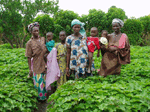Land Deals under the Spotlight in Africa
Published on Thu, 2011-08-25 07:23
Source: Third World Network As foreign capitals and hedge funds continue to make more forays into Africa's land resources, a study has unearthed some surprising findings about the identity of some of the principal investors, according to research by the US-based think-tank Oakland Institute. Swathes of land in Africa are being snapped up by investors and hedge funds, often at the expense of local inhabitants, with promises of benefits that may not materialise, wrote journalist Chee Yoke Heong, researcher with the Third World Network, in an article about the report published by Third World Resurgence. Lured by the prospects of high returns and attractive incentives offered by African governments, foreign and domestic investors are buying or leasing land across the continent as a means to secure land to grow food for markets back home, engage in export commodity production or merely for speculation. In return, the investors offer to provide jobs and development to the areas they have acquired. But instead of bringing hope to the local population, large-scale unregulated investment in land in Africa is resulting in food insecurity, displacement of local farmers and farms to make room for cash crops, environmental degradation and heightened risk of political instability in the continent, according to research by the US-based think-tank Oakland Institute. Chinese, Indian and Middle Eastern parties may have been actively buying up land in Africa, but the Institute believes that Western companies, individuals and investment funds play a bigger role in African land acquisitions. It also named US universities like Harvard and Vanderbilt as among those joining the bandwagon through their investment in firms such as London-based Emergent Asset Management, which was founded by former traders at major banks Goldman Sachs and JP Morgan. US firms also invest using subsidiaries registered in other countries, such as Petrotech-ffn Agro Mali, which is a subsidiary of Petrotech-ffn USA. European firms are also involved, often with support from their governments. Swedish and German firms have strong interests in the production of biofuels in Tanzania while the major investors in Sierra Leone include Addax Bioenergy from Switzerland and Quifel International Holdings from Portugal. And Sierra Leone Agriculture is actually a subsidiary of the UK-based Crad-L (CAPARO Renewable Agriculture Developments Ltd.). 'The same financial firms that drove us into a global recession by inflating the real estate bubble through risky financial manoeuvres are now doing the same with the world's food supply,' said Anuradha Mittal, executive director of the Oakland Institute. She warns that the conversion of African small farms and forests into a natural-asset-based, high-return investment strategy can drive up food prices and accelerate climate change. The justifications put forward by the governments of Africa, investors and international institutions for the large-scale leasing and sale of lands are that investment is needed to modernise Africa's agriculture through transfer of technology, spur infrastructure and economic development, and generate employment and foreign exchange through export of food and commodities. But the Oakland Institute study, which covers seven African countries, confirms many existing findings which show that large-scale land acquisitions do not necessarily produce the promised benefits for local populations. The investors, government officials and the local elites are among those who would gain most from the leasing and sale of land, with limited positive impacts on the livelihoods of the local communities. This situation is attributed to the land policies and generous fiscal incentives which facilitate what has come to be known as 'land grabbing', as investors - foreign, domestic and diaspora - cash in on the very attractive investment climate. For instance, contracts for large-scale agricultural investors in Sierra Leone allow 100% foreign ownership in all sectors with no restrictions on foreign exchange, full repatriation of profits, dividends and royalties, and no limits on expatriate employees. Land is also cheap. Sierra Leone officially stipulated that investors pay $12 per ha per year but even this low price is not respected largely because it is non-binding. As such, Sierra Leone Agriculture pays only $2 per ha per year, while for Quifel Agribusiness (SL) Ltd., payment starts at $5 per ha per year. In Gambella, Ethiopia, the Indian company Karuturi initially received their land for just $1.25 per ha but subsequent negotiation with the federal government has raised the price to $6.75 per ha. In contrast, rates for Brazil or Argentina were $5,000-6,000 per ha. These prices are a bargain for the investors but they do not provide greater incomes for the host governments. The Oakland Institute study further shows how local economies are negatively impacted where investments took over land from active and productive businesses and farms. An example is the case of women farmers in Mali who lost the vegetable gardens they used to grow fresh food for the markets. Agriculture investments were supposed to improve food security of the countries targeted by the investors but instead many small farmers are being forced out of their lands and small and local food farms had to make way for export commodities such as biofuel crops and cut flowers. In Mali, for instance, half of the investors with large holdings intend to grow plants used to produce biofuels, such as sugar cane and jatropha. In Mozambique, most of the investments are in the timber industry and biofuel production rather than food crops. As to whether land investment will create jobs as touted by its proponents, the Oakland Institute research finds that in the countries it covers, the promises of job creation are often overstated or have yet to materialise. Addax Bioenergy in Sierra Leone employed only about 200 people as casual labourers among over 13,000 affected by its project that involved 32 villages. This left the rest of the population in its project area without land to farm and without work. The company also promised development in the form of schools, health facilities and water wells but to date none of these has materialised.
|
SUSCRIBE TO OUR NEWSLETTER



